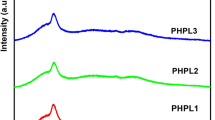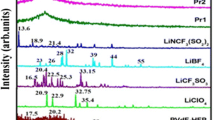Abstract
Polyvinylidene difluoride (PVDF)–lithium bis(oxalato)borate (LiBOB) solid polymer electrolytes (SPEs) have been prepared by solution casting. The highest ionic conductivity achieved is 3.4610−3 S cm−1. Electrochemical potential window of the SPEs is found around 4.7 V. Interaction between PVDF and LiBOB is studied systematically. The changes of C–C, CF2, and CH2 vibration modes with an emerging shoulder are analyzed. At higher salt content, this shoulder becomes more prominent peak at the expense of CF2 vibration mode. This suggests the possible Li+⋯F coordination. Deconvolution of IR spectra region from 1750 to 1850 cm−1 has been carried out to estimate the relative percentage of free ions and contact ions. The finding is in good agreement with conductivity and XRD results. When more salt is present, the number of free ions percentage increases and the Full width at half-maximum (FWHM) of (110) plane is broadening. The Li+⋯F interaction breaks the folding patterns of polymer chain and enhances amorphousness domain.












Similar content being viewed by others
References
Abraham K, Alamgir M (1994) Room temperature polymer electrolytes and batteries based on them. Solid State Ionics 70:20–26
Kerr JB, Sloop SE, Liu G, Han YB, Hou J, Wang S (2002) From molecular models to system analysis for lithium battery electrolytes. J Power Sources 110(2):389–400
Xu JJ, Ye H (2005) Polymer gel electrolytes based on oligomeric polyether/cross-linked PMMA blends prepared via in situ polymerization. Electrochem Commun 7(8):829–835
Stephan AM, Nahm K (2006) Review on composite polymer electrolytes for lithium batteries. Polymer 47(16):5952–5964
Edström K, Brandell D, Gustafsson T, Nyholm L (2011) Electrodeposition as a tool for 3D microbattery fabrication. Interface-Electrochem Soc 20(2):41
Scrosati B, Garche J (2010) Lithium batteries: status, prospects and future. J Power Sources 195(9):2419–2430
Zoppi R, Fonseca C, De Paoli M-A, Nunes S (1996) Solid electrolytes based on poly (amide 6-b-ethylene oxide). Solid State Ionics 91(1):123–130
Bakker A, Lindgren J, Hermansson K (1996) Polymer electrolytes based on triblock-copoly (oxyethylene/oxypropylene/oxyethylene) systems. Polymer 37(10):1871–1878
Liu P, Verbrugge M, Soukiazian S (2006) Influence of temperature and electrolyte on the performance of activated-carbon supercapacitors. J Power Sources 156(2):712–718
Loy DA, Shea KJ (1995) Bridged polysilsesquioxanes. Highly porous hybrid organic-inorganic materials. Chem Rev 95(5):1431–1442
Schubert U, Huesing N, Lorenz A (1995) Hybrid inorganic-organic materials by sol-gel processing of organofunctional metal alkoxides. Chem Mater 7(11):2010–2027
Choe H, Giaccai J, Alamgir M, Abraham K (1995) Preparation and characterization of poly(vinyl sulfone) and poly(vinylidene fluoride)-based electrolytes. Electrochim Acta 40(13):2289–2293
Song J, Wang Y, Wan C (1999) Review of gel-type polymer electrolytes for lithium-ion batteries. J Power Sources 77(2):183–197
Cha BJ, Yang JM (2006) Effect of high-temperature spinning and PVP additive on the properties of PVDF hollow fiber membranes for microfiltration. Macromol Res 14(6):596–602
Xu K, Zhang S, Poese BA, Jow TR (2002) Lithium bis(oxalato)borate stabilizes graphite anode in propylene carbonate. Electrochem Solid-State Lett 5(11):A259–A262
Xu K, Zhang S, Jow TR, Xu W, Angell CA (2002) LiBOB as salt for lithium-ion batteries: a possible solution for high temperature operation. Electrochem Solid-State Lett 5(1):A26–A29
Xu K, Zhang S, Jow TR (2003) Formation of the graphite/electrolyte interface by lithium bis(oxalato)borate. Electrochem Solid-State Lett 6(6):A117–A120
Jiang J, Dahn J (2003) Comparison of the thermal stability of lithiated graphite in LiBOB EC/DEC and in LiPF6 EC/DEC. Electrochem Solid-State Lett 6(9):A180–A182
Jiang J, Dahn J (2004) ARC studies of the thermal stability of three different cathode materials: LiCoO2; Li [Ni0.1Co0.8Mn0.1] O2; and LiFePO4, in LiPF6 and LiBoB EC/DEC electrolytes. Electrochem Commun 6(1):39–43
Wen T-C, Kuo H-H, Gopalan A (2002) The influence of lithium ions on molecular interaction and conductivity of composite electrolyte consisting of TPU and PAN. Solid State Ionics 147(1):171–180
Kim C, Lee G, Liou K, Ryu KS, Kang S-G, Chang SH (1999) Polymer electrolytes prepared by polymerizing mixtures of polymerizable PEO-oligomers, copolymer of PVDC and poly (acrylonitrile), and lithium triflate. Solid State Ionics 123(1):251–257
Holomb R, Xu W, Markusson H, Johansson P, Jacobsson P (2006) Vibrational spectroscopy and ab initio studies of lithium bis(oxalato)borate (LiBOB) in different solvents. J Phys Chem A 110(40):11467–11472
Noor M, Careem M, Majid S, Arof A (2013) Characterisation of plasticised PVDF–HFP polymer electrolytes. Materials Research Innovations.
Rahaman MHA, Khandaker MU, Khan ZR, Kufian MZ, Noor ISM, Arof AK (2014) Effect of gamma irradiation on poly(vinyledene difluoride)–lithium bis(oxalato)borate electrolyte. Phys Chem Chem Phys 16(23):11527–11537
Wang S, Qiu W, Li T, Yu B, Zhao H (2006) Properties of lithium bis(oxalato)borate (LiBOB) as a lithium salt and cycle performance in LiMn2O4 half cell. Int J Electrochem Sci 1:250–257
Acknowledgments
The authors gratefully acknowledge the financial grant from the University of Malaya through RU022G-2014 and Ministry of Higher Education of Malaysia (MOHE) through FP053-2014A. Faisal I. Chowdhury would like to thank University of Chittagong, Bangladesh for financial support.
Author information
Authors and Affiliations
Corresponding authors
Rights and permissions
About this article
Cite this article
Chowdhury, F.I., Khandaker, M.U., Amin, Y.M. et al. Vibrational, electrical, and structural properties of PVDF–LiBOB solid polymer electrolyte with high electrochemical potential window. Ionics 23, 275–284 (2017). https://doi.org/10.1007/s11581-016-1857-0
Received:
Revised:
Accepted:
Published:
Issue Date:
DOI: https://doi.org/10.1007/s11581-016-1857-0




